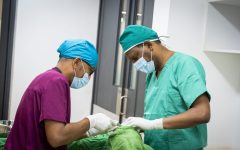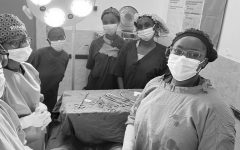As UGHE’s 2020 GHDLP Program Comes to a Close; Meet the First-Ever Francophone Cohort Ahead of Their Reconvening
November 9, 2020 2020-11-09 14:23As UGHE’s 2020 GHDLP Program Comes to a Close; Meet the First-Ever Francophone Cohort Ahead of Their Reconvening
As UGHE’s 2020 GHDLP Program Comes to a Close; Meet the First-Ever Francophone Cohort Ahead of Their Reconvening
The breadth and success of UGHE’s first-Francophone GHDLP program can be summarized neatly into numbers. In February this year, UGHE welcomed seven country groups from Francophone African countries to Rwanda for a fourteen day intensive residency to kick-start the program. Participants learned from the expertise of six world-class faculty and, over the course of eight months, developed seven cutting-edge projects that address some of the most pressing global health challenges threatening populations within their country contexts.
This month, UGHE welcomed all participants and coaches back, albeit virtually, for a final reconvening and graduation from the program. The three-day event saw participants from each country group present their findings, as well as what they have learned from their respective Breakthrough Projects, while receiving valuable peer-to-peer feedback and recommendations from their coaches and guest evaluators.
Below is a glimpse into the Breakthrough Project process of three country groups — Mali, Niger, and Central African Republic — as well as an opportunity to meet the participants themselves.
Ly Diénéba (Mali)
A little about Mali’s Project:
The Mali GHDLP country group set out to analyze the low tuberculosis case detection rate – currently standing at 42% – in the region of Segou; a town and an urban commune in south-central Mali, with the ultimate aim to increase the area’s tuberculosis case detection rate from 42% to 60% by the end of 2022.

Q. Can you tell me a little more about your project, and whether the scope of it changed from its inception?
The problem itself has not changed; there is still insufficient diagnosis of tuberculosis in many parts of the country, which we were hoping to improve as a key objective of our project. Whilst over its course we did not alter the scope of our project too much, we changed the sites where we wanted to put the project into practice, as well as the numerical objective. We had originally chosen a region where the rate was the lowest, but against the backdrop of the security crisis in Mali, and following a displacement in the original area, we felt we couldn’t travel to this region. So, we chose another region not too far from the capital from which we could better study the detection rate. From the new site, we were able to interview the key stakeholders at the health center level, and to pinpoint the main cause of the low detection rate. This enabled us to directly address the challenges by using a network of trained community health workers.
Q. What are the socio-economic obstacles to case detection and how does your Breakthrough Project serve to address them?
We know TB is a disease that is stigmatized in this context, and some suspected active cases reported great difficulty in going to health centers for testing. We seek for those at the community health worker level to have more contact with the population in order to detect contact cases as soon as someone is positive. It is this intervention at the regional level that we are targeting. We want to train community health workers in a) pathology, b) how to contact trace TB successfully, and c) how to refer patients or suspected patients to the health center level. Our ultimate aim is to increase the rate of diagnosis in this region and, if successful, scale up this project to other regions throughout Mali. In time, we want to be able to send community health workers the resources – the tablets and tools – in order to be able to properly implement these activities themselves.
Q. How have the leadership and management skills acquired throughout GDLP prepared you for the next chapter in advancing access to health in this area?
I think the most important thing for us to have learned, was how to approach and access a problem; in this case, an accurate TTB level, which is a major problem in Mali. By using our leadership skills gained from this program, we agreed to pursue the project collaboratively and compile the results after meeting with the stakeholders. It was also useful to learn how to explain the project clearly, making sure that the team on the ground was motivated and understood that what we are doing through our research is of benefit for the region and for the fight against Antigen Presenting Cells. Ultimately, through this program we learned that this kind of project cannot be successful without having a robust and collaborative framework to approach the research, assigning clear roles and responsibilities, and conducting it through a participatory approach; with all of the stakeholders in the field.
Oumarou Maigari (Niger)
A little about Niger’s Breakthrough Project:
In Niamey, the capital and largest city of the West African country of Niger, 15% of TB patients were lost to follow up at the CNTMR. Through their Breakthrough Project, the Niger country group aimed by 2021 to reduce the number of TB patients lost to follow up at the National Treatment Center for Multi-drug Resistant Tuberculosis (CNTMR) in Niamey by 30% .

Q. Given the concern that 15% of TB patients are lost to follow-up at the CNTMR in Niamey, what do you feel are the main causes linked to the loss of patients in follow-up?
There are many causal factors that we aimed to highlight throughout our Breakthrough Project. Many in Niger’s population prefer to travel to Niamey, Niger’s capital, when they are sick, because they feel the capital is better equipped in terms of health infrastructure than the rest of the country. Once they arrive, they get tested and, if positive, they are put on treatment. When their health begins to improve, the patients then leave to go back to their districts making them difficult to track. Furthermore, during the dry season, many may migrate to settle on the outskirts of Niamey. Once winter sets in, this population will return to their village, and thereby are difficult to follow.
We identified these two main reasons for the number of patients lost to follow up, but we are exploring other underlying factors, such as patient aftercare. We are in the process of reviewing the counseling provided to patients and the guidance we provide screened patients to ensure that they follow up with their treatment to its completion.
Q. How did you go about improving TB monitoring at the CNTMR?
We have made certain to fully integrate the Community Health Workers (CHWs) into the project, so that each time a multi-drug resistant TB (MDR TB) patient is detected, we identify which CHW is closest to his or her home, and brief them fully so that they can track and regularly check up on the patient to ensure their treatment is completed. We are seeing this has been successfully implemented with the various CHWs across ten houses in each neighborhood. Specifically, the CHWs will be involved once a case has been confirmed, and will take responsibility for monitoring patients’ symptoms, making sure appointments at health centers are kept, and that patients are taking the medicines prescribed to progress with their treatment.
Q: How did the learnings from GHDLP 4.0 provide the foundations for your Breakthrough Project?
For me, one of the most important things about the GHDLP program is that it is a practice-oriented program that addresses daily challenges. During the training we were each asked to identify the issues we were experiencing in our professional lives, as well as within our region, and across the wider country, in order to identify what could be done to address these challenges. As we work in tuberculosis management, we are very familiar with TB statistics, and so it was only natural that we arrived at this challenge. I think the tools we have been given in this training program, including guidance on how to communicate effectively, how to define a problem, how to define objectives, and how to assess all of these, has provided an essential foundation for the progress of our project.
Noelly Dominique Marcelle Donon Kpagnami Nee Douma (Central African Republic)
A little about the Central African Republic (CAR)’s Breakthrough Project:
75% of children under the age of five who are suffering from malaria in the CAR still do not receive appropriate treatment according to national protocols for health facilities. The CAR team has sought, through their Breakthrough Project, to support the reduction of this figure by 25%.

Q. What are the underlying factors of the problem you have identified within your Breakthrough Project?
In the observations we made within our initial research, using health reports and other credible sources, we noted that some of the challenges started from the top. For example, in some places there is a lack of information from those responsible for health information, especially within peripheral health centers. Some of the personnel working in these centers are unqualified, meaning they have not received proper training. Consequently, they do not have adequate, or reliable information about malaria, and therefore cannot provide the appropriate treatment according to the national protocols and directives concerning malaria. This serious issue can result in premature discontinuation of treatment.
Normally, there are treatment algorithms that are in place in hospitals, so that whenever the provider is providing treatment, they can check these algorithms. The problem is that many of these treatment algorithms are not yet developed, or if they are, they have not yet been made widely available. Sometimes the guidelines around treatment are also not well popularized due to staff turnover, and therefore some health care providers start their role unaware of the guidelines in effect, or they may make up their own as they go. All of these issues will greatly impact the care of under five-year-old children in these areas.
Q. How did GHDLP 4.0 lead you to this specific project and what tools did it equip you with to use in this project?
We began planning the focus of our project during the training and, together with the faculty at UGHE, refined the project. The program helped guide us on how best to develop the project when returning home to our respective countries. Our project coach supported us throughout the research process to the project’s completion. In facing any challenges, our coach was always available to provide expert guidance, as well as advise as to how to overcome any obstacles without deviating from our project objectives.
***
Clearly, UGHE’s GHDLP program has been instrumental in the success of these imperative projects in improving interventions for TB and malaria, in addition to projects not included here focussing on HIV. The Center for Executive Education is proud to have supported this initial Francophone program and looks forward to future Francophone programming. Find out more about the GHDLP program here.







